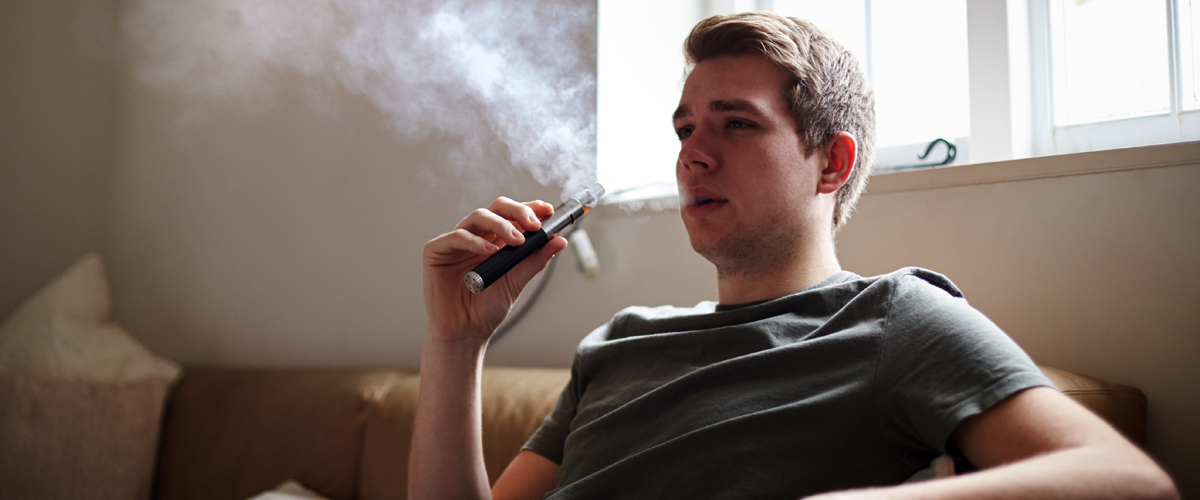Vaping and COVID-19: Can Vaping Increase Complications?
Coronaviruses are respiratory infections that can attack the lungs, potentially putting those who vape at higher risk of complications from COVID-19.

The new coronavirus that causes the disease COVID-19 is from a family of viruses that causes respiratory infections. That’s why people with chronic lung disease or moderate to severe asthma are among individuals at higher risk for severe illness from COVID-19.
This also means that people who engage in behavior that affects their lungs — including smoking and vaping — also may be at a higher risk of complications if they contract the disease, according to the National Institute on Drug Abuse. The Centers for Disease Control and Prevention has found that 20% of patients sick enough to be hospitalized are ages 20 to 44, and some health authorities are speculating whether there is a connection between this age group’s hospitalization rate and the high rate of vaping among this same cohort.
To better understand the potential link between vaping and COVID-19, Health Matters spoke with Dr. Brendon Stiles, former associate attending cardiothoracic surgeon at NewYork-Presbyterian/Weill Cornell Medical Center and associate professor of cardiothoracic surgery at Weill Cornell Medicine.
Is there a reason to believe people who vape are more at risk of developing serious complications from COVID-19? If so, why?
Certainly we know that vaping itself can lead to inflammation and profound lung disease, as well as to a malfunction of the immune system in the lungs. I would therefore expect that those who vape or smoke may be more susceptible to pulmonary complications following a COVID-19 infection.
How does COVID-19 harm the lungs?
COVID-19 can damage the lining of the air sacs in the lungs (alveoli) where oxygen is delivered to the blood. As those sacs fill with fluid, dead cells, and other debris, it prevents oxygen from getting through. The filling up of the air sacs is what causes the typical white appearance of the lungs on a chest X-ray or CT scan of a patient with COVID-19 pneumonia or pneumonitis. The air sacs normally are full of air and appear black on radiographic studies. When the lungs have to work harder or when there is decreased oxygen supply to other body organs, more stress is placed on those organs, and they are more susceptible to failure.
What are some of the lung conditions caused by vaping or smoking that could make COVID-19 symptoms worse or cause serious complications?
Vaping can cause EVALI (e-cigarette or vaping associated lung injury), a broad descriptor of acute respiratory illness. It generally can manifest with shortness of breath, cough, and rapid and shallow breathing. Studies evaluating the pathological changes in the lungs of people who vape have described acute inflammation, damage to the air sacs that are necessary for oxygen exchange, and focal spots of pneumonia. All these changes may induce a chronic obstructive pulmonary disease (COPD)-like illness. I would expect that COVID-19 would amplify any of these changes.
Could vaping be a reason for the number of young people diagnosed with COVID-19?
Right now we don’t know how vaping habits among young people are connected to COVID-19, but it has been curious that hospitals across the country are seeing younger patients who are quite sick, some of them requiring intubation and ventilation. One theory is that it is more likely that younger people were slower to take up social distancing and to self-isolate when they had early symptoms. Once we get past this initial surge and have a chance to look closely at the data, it will be interesting to sort out whether those patients who needed intubation had a history of smoking or vaping or of other underlying lung disease.
Some reports show that the new coronavirus is more deadly for men than women. Do smoking rates play any role in this?
Early data from China and Italy seem to suggest that men are somewhat more likely to be infected than women, but also suggest that death rates in men might be 65% to 75% higher than in women. The reasons for this aren’t entirely clear at this point. It may be that men are more likely to smoke than women in these countries and, thus, likely to have more significant underlying lung disease. This could predispose them to respiratory failure and death. There are also some interesting theories and some previous experiments that suggest estrogen may be somewhat protective against viral infections.
What advice would you give people who vape?
I remind patients that the harms of vaping have been well documented. It is clear that vaping may increase nicotine addiction, is strongly associated with acute lung injury, and potentially causes cancer down the road. This would be a great time to quit and a terrible time to start.
Brendon Stiles, M.D., is a former associate attending cardiothoracic surgeon at NewYork-Presbyterian/Weill Cornell Medical Center and associate professor of cardiothoracic surgery at Weill Cornell Medicine. Dr. Stiles is an advocate for lung cancer patients and for cancer research in general. He is chair of the Lung Cancer Research Foundation’s Board of Directors. Dr. Stiles can be found on Twitter, @BrendonStilesMD, where he frequently comments on lung cancer, engaging directly with patients and advocacy groups.
Additional Resources
If you have concerns regarding COVID-19, please call NewYork-Presbyterian’s hotline at 646-697-4000. This hotline is available as a public service to provide information only and not diagnose, treat, or render a medical opinion.
